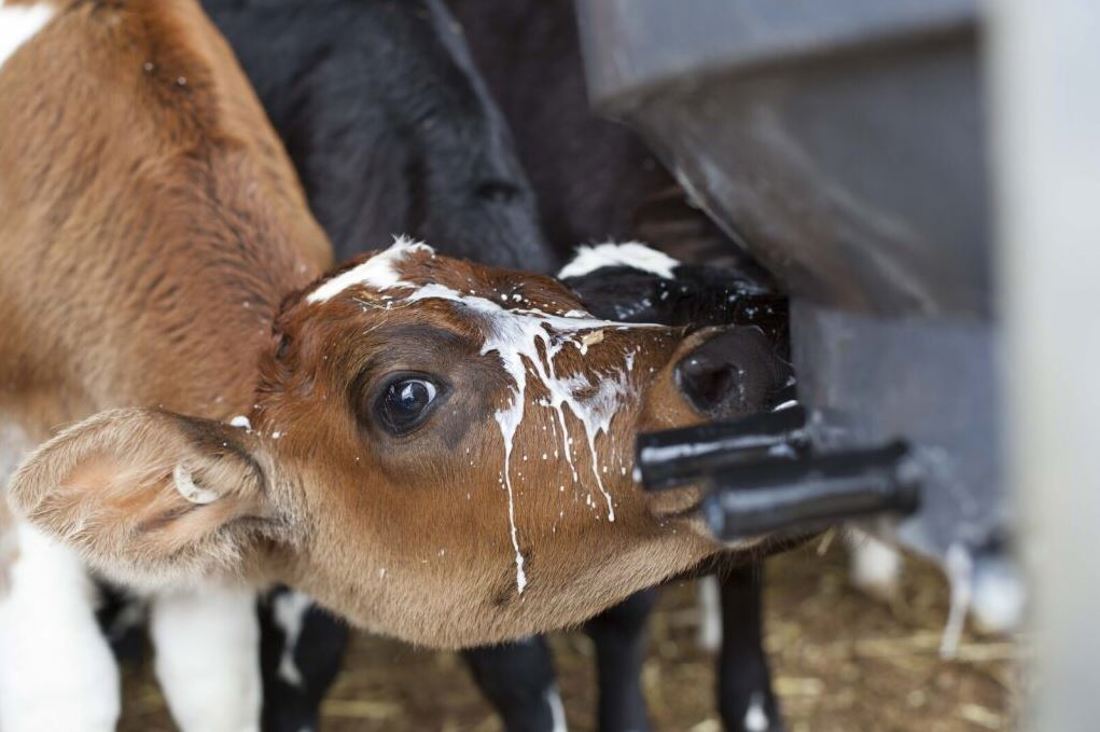Feeding milk
3 min read
To ensure optimal growth, health, and well-being of calves, feeding strategies should be considered carefully. Research indicates that feeding a higher daily allowance, split into multiple feeds, is better for calves. Selecting the best system for your farm will help reduce the stress of calf rearing, and ensure your calves get the best start to life.
Calf milk replacer (CMR) is in high demand this spring with more calves being reared for beef. Farmers may need to swap between different milk replacers, or to vat milk to manage shortages. We’ve updated our guidance to support farmers to transition carefully and maintain calf health.
Swapping from CMR to vat milk:
Swapping between different CMRs:
Monitor calves closely during the process and be ready to treat scouring calves with electrolytes to prevent dehydration. Talk to your veterinarian if you need advice on managing scours.
Feeding strategies should provide calves with enough energy for growth and play, ensuring they can mount a strong immune response, and also meet behavioural needs.
Research shows that feeding calves once a day (OAD) for the first two weeks, does not fully provide for their daily nutritional needs. Calves cannot consume enough milk in one sitting to meet their nutritional needs and they will experience hunger.
Feeding milk twice daily for two weeks, allows calves to consume and digest adequate amounts of milk. This provides the energy they need to maintain good health, growth and supports natural behaviour such as running and playing. Ad lib feeding systems also provide these benefits while conserving labour.
Some farms in New Zealand use automated calf rearing systems, which allow the calf to choose when and how often they feed. This mimics the natural feeding behaviour of a calf on a cow. Properly managed, automated systems have been found to reduce nutritional or non-infectious scours and the need for additional labour.
The National Animal Welfare Advisory Committee (NAWAC) are currently reviewing the Dairy Cattle Code of Welfare.
It is unknown when the updated Dairy Cattle Code of Welfare will be released but it is likely to include changes to calf rearing requirements. Until then, the Dairy Cattle Code of Welfare (2019) remains in effect. Read more about DairyNZ's submission on the proposed Dairy Cattle Code of Welfare here:

Calves can be reared economically on both whole milk and, high-quality, reputable milk replacers. In seasonal dairy systems there is often an abundance of surplus milk over spring, and many farms cannot justify the use of milk replacers on economic grounds.
Raw milk is a high-risk pathway for the spread of Mycoplasma Bovis (M. bovis) and certain other infectious diseases. Ensure any milk you sell or purchase is traceable by completing a feed declaration form.
There may be other reasons to use milk replacers, including:
When choosing to use a milk replacer, calves need time to adapt to the new diet. This can be achieved by initially mixing replacer with colostrum/whole milk to let them adjust between the two feeds. Consistency is key to the success of milk replacers. Always read the label and mix according to the directions.
Automated calf feeding systems can achieve good results with milk replacers, as the preparation and mixing is consistent. Delivery to the calf and cleaning of the system is often easier and works better with freshly mixed milk powder.
Protein and fat are two key components of your feed that should be considered when comparing milk replacers.
Protein content and source of protein in milk replacers can vary significantly. Calves respond best to dairy-based proteins compared to plant-based proteins. Not all milk replacers will state the protein source, so ensure that you use reputable products that have proven results when feeding young calves.
Calves will require around 22-25% of protein on a dry matter basis to support growth and development. The faster your growth plan, the higher the protein content required.
Milk replacers commonly provide less fat than whole milk, ranging between 18-22% on a dry matter basis. Higher fat products may be valuable under ad-lib, or high growth situations. Higher fat diets can also be beneficial to calves during colder conditions as they provide added energy.
Feeding infected milk is high risk for spreading diseases such as M. bovis. Milk that has the lowest risk of containing M. bovis bacteria comes in these forms: calf milk replacer powder, acidified milk, or pasteurised milk.
If you’re feeding whole milk, consider the following:
Do not acidify below pH 4 as this will result in thickened milk and risks complete coagulation. Calves will not drink milk with a pH of 4 or below.
Now’s the perfect time to check in, plan, and set up for a strong season. We’ve pulled together smart tips and tools to help you stay ahead all winter long.
Whether you prefer to read, listen, or download handy guides, we’ve got you covered with trusted tools to support your journey every step of the way.
Put our proven strategies and seasonal tools to work. Boost production, support animal health and watch your profits hum.
Tools that are backed by science, shaped by farmers and made for this season.
That’s Summer Smarts.